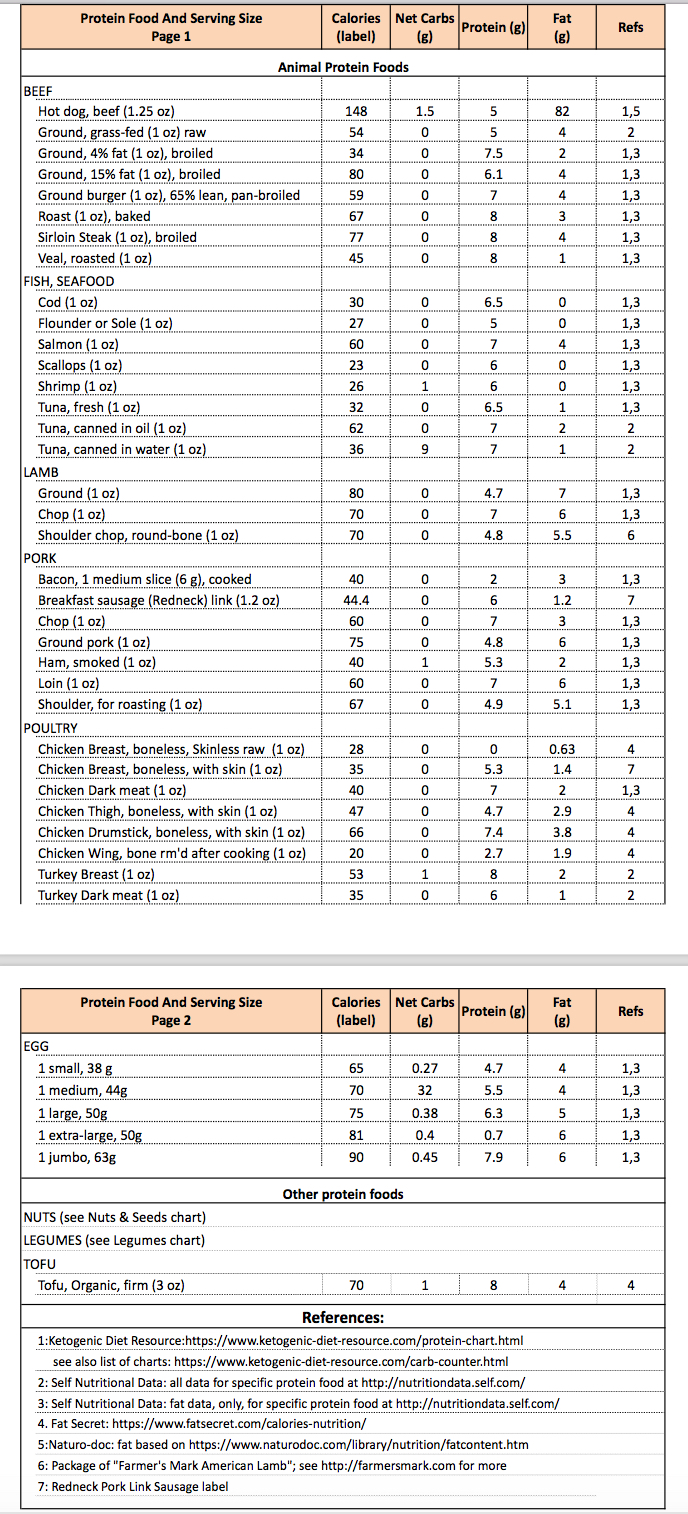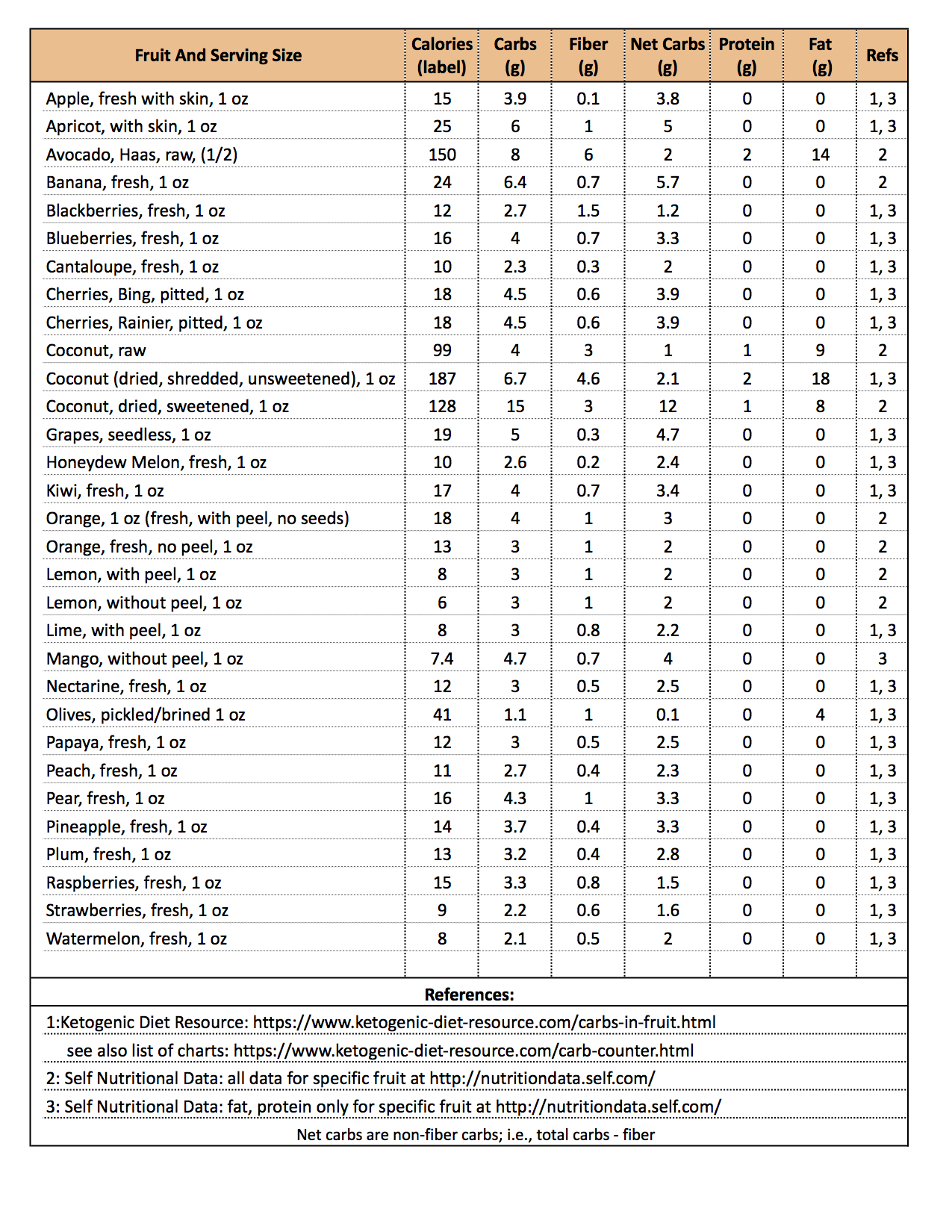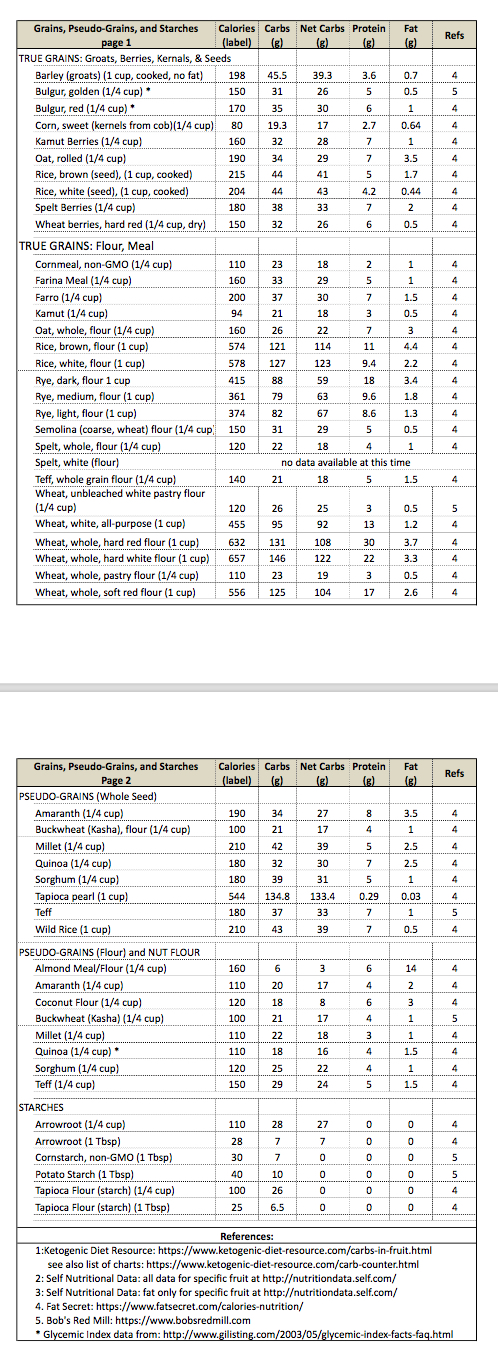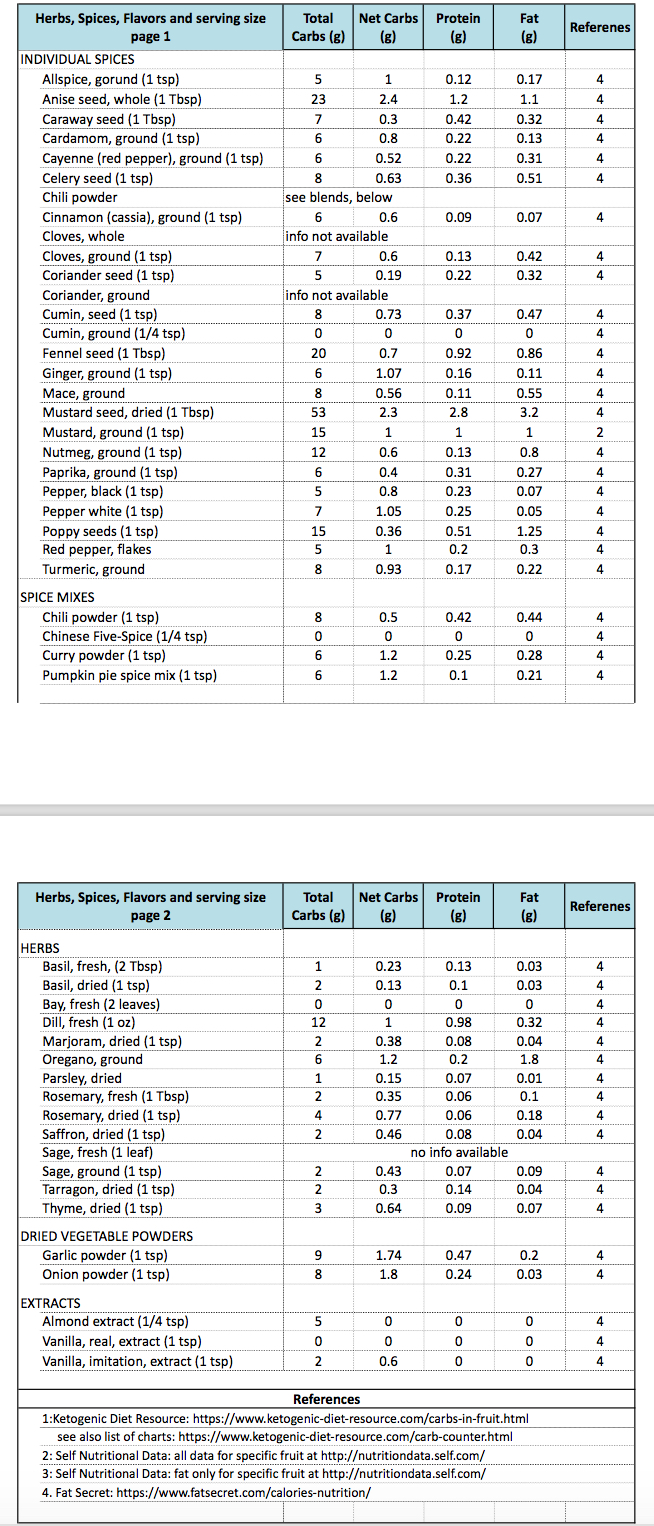
by Catherine M. Haug, June 22, 2013; updated Apr 2019
These counters provide nutrient information: (carbs, protein and fat) for various categories of foods (See “Includes” list below). Note that two types of carbs are indicated in the tables:
- Total Carbs, which include all forms of carbohydrates: sugars, starches and fiber; and
- Net Carbs, which exclude fiber. Only Net Carbs is used to calculate calories in each food (for my tables).
I use an acronym for net grams (g) and calories (cal) by nutrient type: CPF for Carbs/Protein/Fat per listed serving size (oz, cups, etc). For example, 1 oz of ground beef has CPF=0/7/5 grams, which is 0 g net-carb, 7 g protein and 5 g fat in 1 oz of ground beef. I will be adding foods to the charts from time to time, and updating the pdf files accordingly.
- Includes: 1. Links to printable pdf version of each chart; 2. CPF Charts for the following foods: Protein, Veggies, Fruits, Fats, Dairy, Nots & Seeds, Legumes, Grains/Pseudo-Grains/Starches, Spices/Herbs/Extracts, and Condiments
- See also (this site): 1. Diet and Health Menu; 2. Ketogenic Diet (Intro); 3. Keto Daily Outline; 4. CKD: Cyclical Ketogenic Diet (CKD) and Metabolic MItochondrial Therapy (MMT)
- See also (other sites): 1. Ketogenic Diet Resource.com (1); 2. NutritionData.Self.com (2); 3. Atkins Diet Carb Counter (pdf) (3); 4. What’s Cooking America: Food Nutrition Chart (4); 5. calorie-charts.net (5); Fat Secret (6)
Carb types (About)
Total carbs include all forms of carbohydrates: sugars, starches, resistant starches, and fiber. Starches and fiber differ as follows:
- Starches are broken down into their individual sugar molecules by your digestive enzymes, and then absorbed into your bloodstream. From there they can be taken up by your body’s cells for fuel. Any sugars that are not taken up by your body’s cells are converted into body fat by your liver.
- Resistant Starches behave more like fiber than starch during digestion; the sugar chains are not easily broken down into individual starches; instead, the good bugs in your gut microbiome ferment them into fatty acids.
- However, for some foods (such as potatoes), their resistant starches are easily broken down (like regular starches) when the food is hot, and are preferentially fermented (like fiber) when the food is cooled. For this reason, it is hard to predetermine grams fiber vs grams starch for these foods. Instead, I include them in net carbs on my charts. See my article: Resistant Starches, for more.
- Fiber is not broken down into sugars because your body doesn’t provide enzymes to do that work. Instead, the bugs in your gut microbiome ferment the fiber into other things such as fatty acids, that are then absorbed into your blood stream and are taken up by your body’s cells for uses other than fuel; for example, to become part of the cell membrane. Some of these fatty acids can be converted into ketones which can be used as an alternative fuel. Net carbs do not include fiber; that is, they include only glucose (sugar) and starches that can be broken down into sugar.
CPF CHARTS
NOTE: In what follows, the term “CPF” stands for “Carbs / Protein / Fats” in a specified food, or for meal totals. It is used for:
- CPF grams (grams of carb, protein, and fat);
- CPF calories (calories of carb, protein, and fat);
- % CPF calories (% calories for carb, protein and fat).
NOTE: Calories reported in my charts are calculated from grams for CPF (4 calories/gram of carbs and protein; 9 calories/gram of fat). This may differ from total calories reported on the food’s label.
Charts, in order of presentation:
NOTE: links are for the printable pdf version of the specified chart displayed in this article, below.
- Protein foods; see also CPF Counter-Protein2c.pdf
- Legumes; see also CPF Counter-Legumes2b.pdf
- Veggies; see also CPF Counter-Veggies2.pdf
- Fruits; see also CPF Counter-Fruits2.pdf
- Dairy, and Non-Dairy Milks; see also CPF Counter-Dairy-SeedMilk2b.pdf
- Fats & Oils; see also CPF Counter-Fats-Oils2a.pdf
- Nuts & Seeds; see also CPF Counter-Nuts-Seeds3a.pdf
- Grains, Pseudo-Grains & Starches; see also CPF Counter-Grains-Starches2a.pdf
- Herbs, Spices & Extracts; see also CPF Counter-Spices-Herbs.pdf
NOTE: the jpeg versions shown in this article are a bit fuzzy; they should be more clear in the pdf versions (available by clicking on the pdf link).
Chart for Protein Foods
This list is primarily for animal-source protein (meats, organ meats, seafood, eggs), which are generally low in carbs. Nuts, seeds and legumes are also considered protein foods, but are in separate files; see Nuts and Seeds and Legumes, below.
See printable pdf: CPF Counter-Protein2c.pdf (2-page file). The chart below is a jpg of the combined 2-pages. NOTE: CPF means carb/protein/fat grams.
Chart for Legumes (beans, peas, lentils)
Most legumes are too high in carbs to be included in a ketogenic diet; however, sprouting them reduces the carbs significantly (see pinto kidney and Cannellini beans in chart below to compare “raw” and “sprouted” stats). Sprouting also breaks down the toxic lectins in the beans. For more about sprouting, see:
- Sprouted Grains, Legumes, Nuts & Seeds (About)
- General Instructions: Sprouting Grains, Legumes, Nuts & Seeds (for eating)
- Lectins: What they are and how to deal with them
- How to Soak, Sprout and Ferment Menu
See printable pdf: CPF Counter-Legumes2b.pdf (1 page). The chart below is a jpg of the chart. NOTE: CPF means carb/protein/fat grams.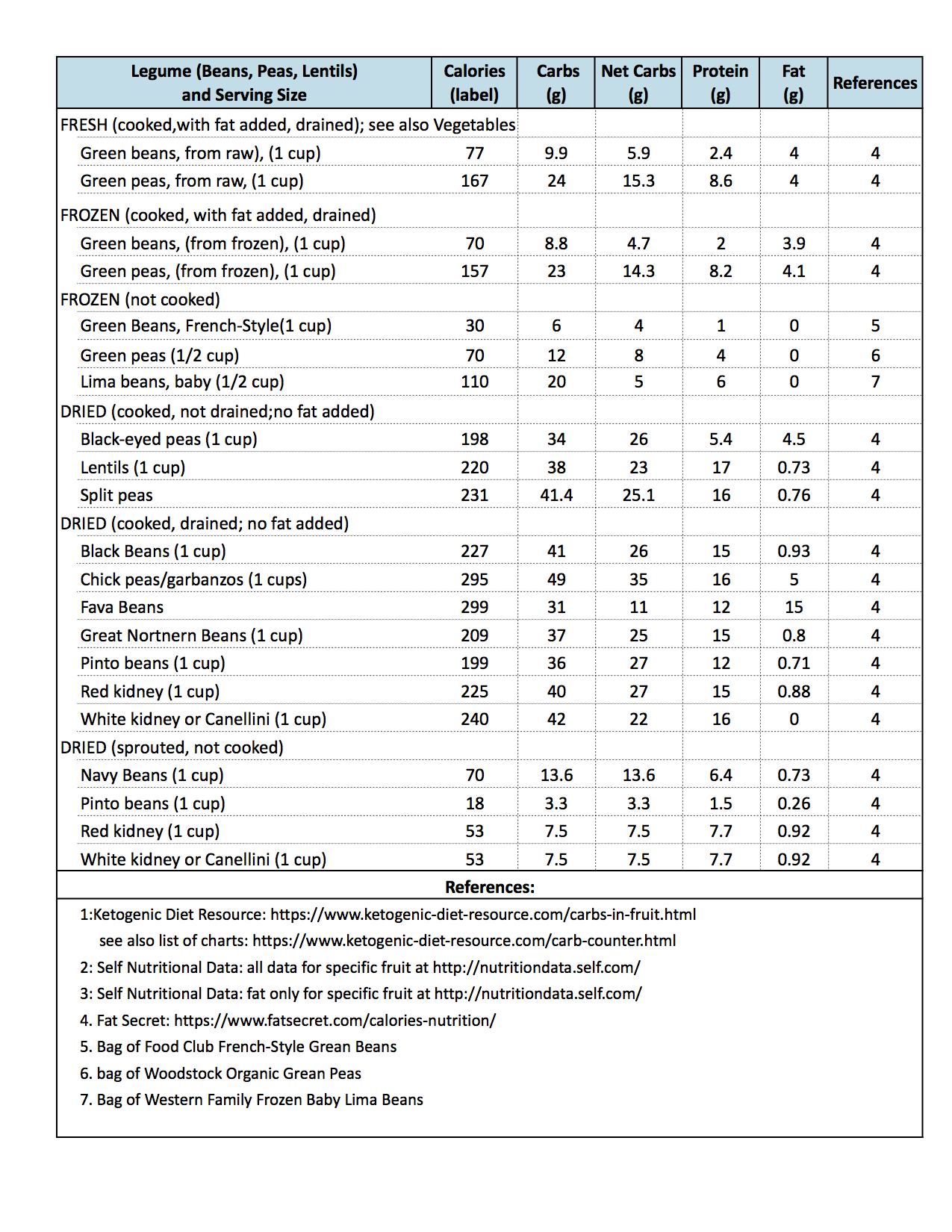
Chart for Vegetable Foods
See printable pdf: CPF Counter-Veggies2.pdf (1page). The chart below is a jpg of the chart. NOTE: CPF means carb/protein/fat grams.
NOTE: the source for “Greens: spring mix & baby spinach, 1 cup” (indicated as “other”) is from a container of Earthbound Farm’s Organic Spring Mix and Baby Spinach product.
Chart for Fruit Foods
See printable pdf: CPF Counter-Fruits2.pdf (1 page). The chart below is a jpg of the chart. See also additional information about CPF for different size of bananas, below the chart. NOTE: CPF means carb/protein/fat grams.
More about “Banana, whole, fresh, peeled;” CPF depends on size of the banana (2):
-
- 1 (under 7”): 101 cal; CPF = 20/1/0
- 1 (7-8”): 105 cal; CPF = 24/1/0;
- 1 (8-9”): 121 cal; CPF = 27/1/0;
- 1 (>9”): cal=135, CPF= 31/2/1
Chart for Dairy (and Non-Dairy Milks)
See printable pdf:
. (1 page). The chart below is a jpg of the chart. Note: the net carbs in my chart are per the product label; however, I don’t count all of them – see “A note about the Net Carbs in quality dairy products,” below the chart. For more about culturing dairy, see:
NOTE: CPF means carb/protein/fat grams.
A note about the Net Carbs in quality dairy products:
The carb in milk and other dairy products is the sugar, lactose, a disaccharide comprised of glucose and galactose. Many people (including my sources for the chart, below) include lactose in net carbs. However, I modify net carbs for dairy products for my own keto plan, because most people do not burn lactose for energy, and calories are all about potential energy in the food.
Why do I modify net carbs for my own keto plan? Very little of the lactose is broken down into its component sugars (glucose and galactose) because our gut bacteria get to it first, and they turn it into lactic acids instead of its component sugars.
Thus:
- For fresh milk and cream, I use only 10% of the stated net carbs; for example, 1 cup whole milk has about 8 grams net carbs, but I count only 0.8 of those grams as net carbs.
- For fermented milk products (e.g., buttermilk, yogurt, kefir and cheese), the added fermenting bacteria digest all of the lactose to lactic acid. I count only 1% of the stated carbs. For example, yogurt has 12 g lactose per cup, but I count only 0.1 of those grams.
However, if the good gut bacteria in your gut is quite low, you should use the original net carbs; that is, for 1 cup whole milk, use 8 grams carbs; etc., until the population of good bacteria improves. One way to improve the level of good bugs in your gut is to take pre-biotic supplements, including lactose supplementally, such as Sweet Dairy Whey, in addition to eating acidophilus/bifidus-rich fermented milk products such as yogurt, to support the good bugs that you do have, and thus help your gut to heal.
Chart for Fats & Oils
This one is easy. For fats like butter, shortening, lard, suet, olive oil, coconut oil, and vegetable oils, there are zero (0) carbs, no matter the serving size. But there are some foods high in fats that do have carbs, such as:
- Avocados are high in fats (see Fruit chart above);
- Nuts and Seeds are fairly high in fats (see Nuts and Seeds chart, below); and
- Dairy cream is fairly low in carbs (see Dairy chart, above).
See printable pdf: CPF Counter-Fats-Oils2a.pdf (1 page). The chart below is a jpg of the chart. NOTE: CPF means carb/protein/fat grams.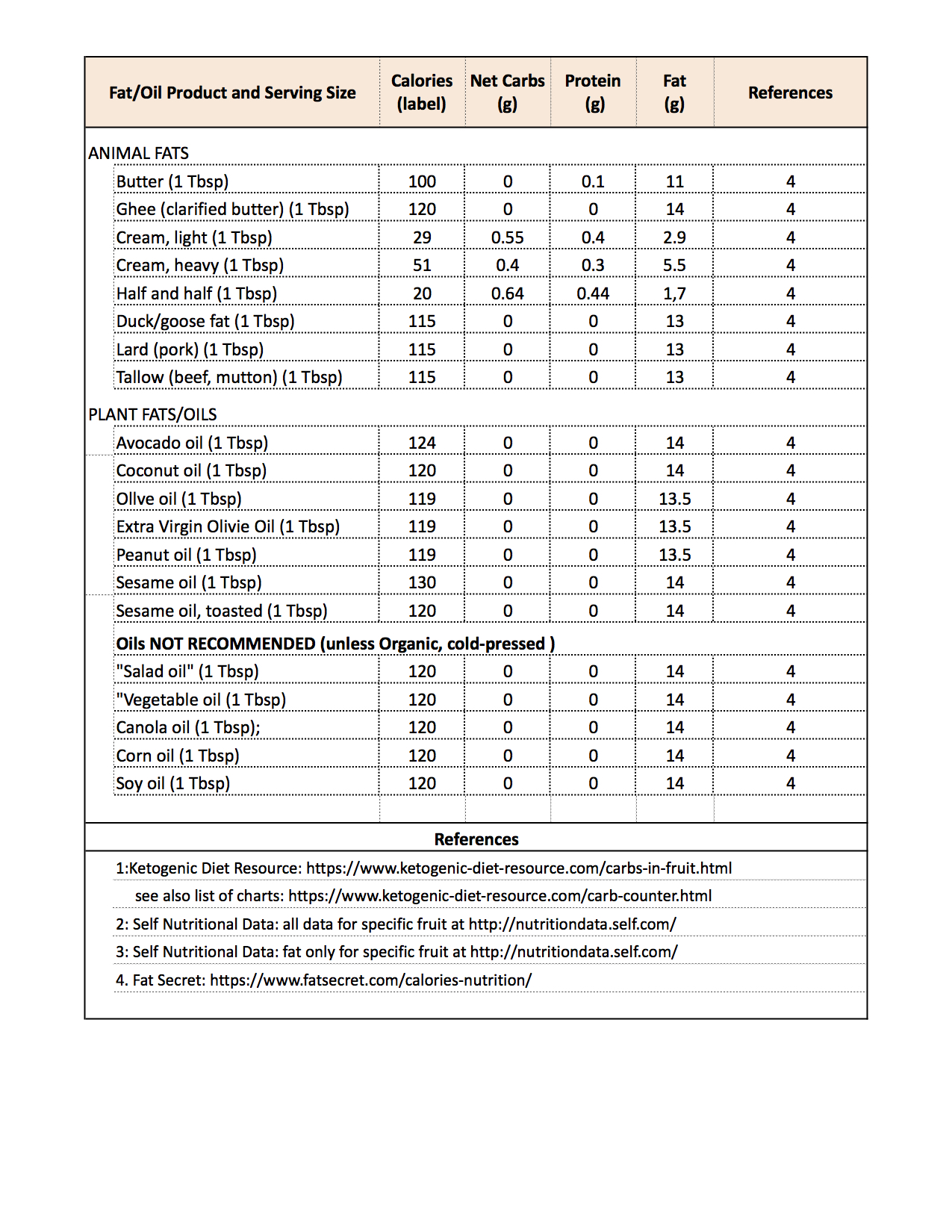
Chart for Nuts and Seeds
Nuts and seeds are considered both protein and fat foods; however, cashews are higher in carbs because technically they are a legume. See also Nut flours in Grains section, below.
See printable pdf: CPF Counter-Nuts-Seeds3.pdf (1 page). The chart below is a jpg of the chart. NOTE: CPF means carb/protein/fat grams.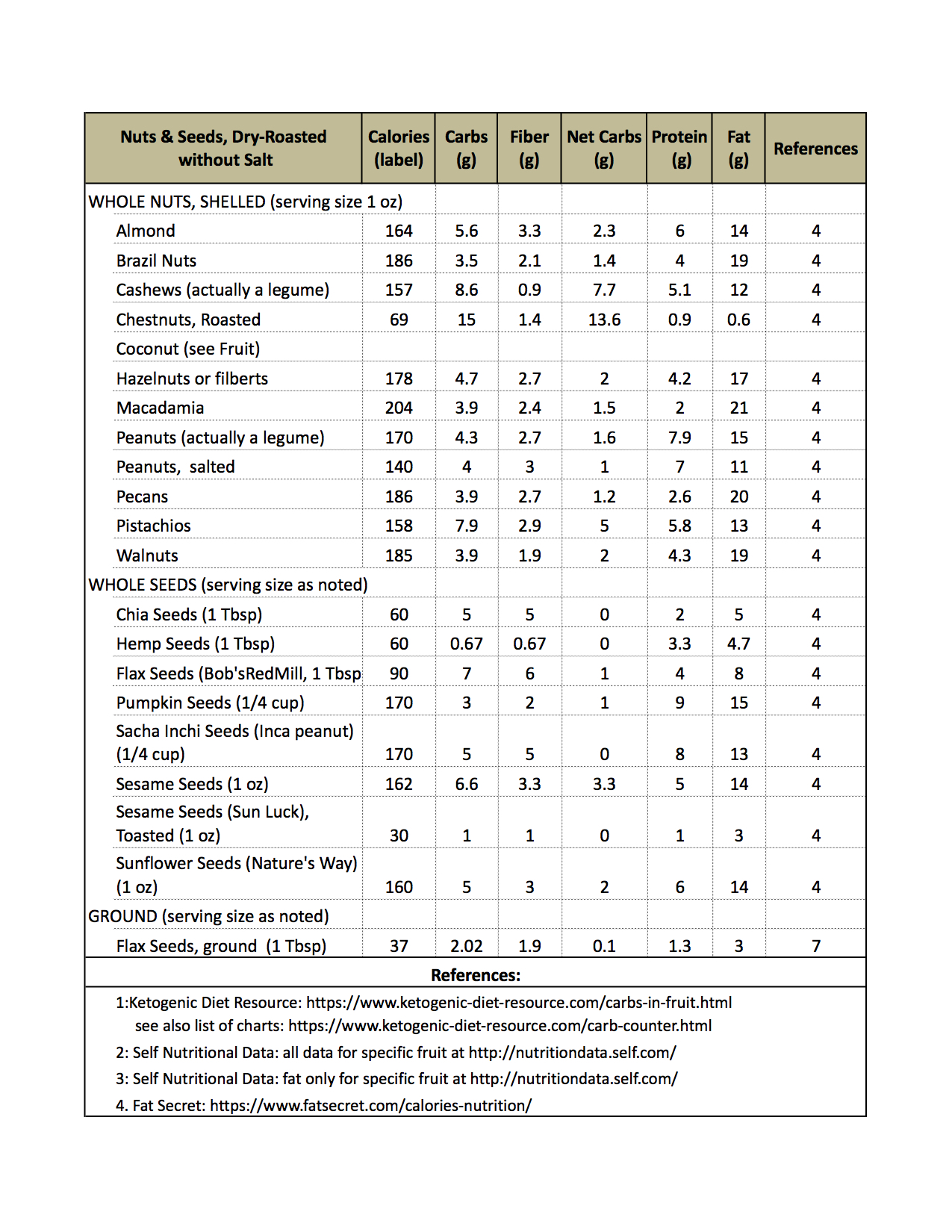
Chart for Grains, Pseudo-Grains, and Starches
NOTE: These seeds have a higher carb level than other types of seeds, so are to be used with caution. Whole-grain has lower net carbs than processed grain (white flour, etc.), and sprouted whole-grain is more healthful than non-sprouted, by breaking down the lectins. For more about sprouting, see:
- Sprouted Grains, Legumes, Nuts & Seeds (About)
- General Instructions: Sprouting Grains, Legumes, Nuts & Seeds (for eating)
- Lectins: What they are and how to deal with them
- How to Soak, Sprout and Ferment Menu
I do not recommend eating in this category for the first 4 – 6 weeks of the diet, and then only 1-2 times a week as part of a Cyclical Ketogenic Diet (CKD).
See below the chart for moe about the best ways to consume grains and pseudo-grains.
Chart for Grains, Pseudo-Grains & Starches
See printable pdf: CPF Counter-Grains-Starches2a.pdf (2 pages). The chart below is a jpg of the chart. NOTE: CPF means carb/protein/fat grams.
(See also Atkins carb counter (3) [I saved a copy: CATSFORK > PDF-NUTRIENT CHARTS / 2013AtkinsCarbCounter.pdf].
The best ways to consume grains and pseudo-grains
- Sprout them (see links above for details).
- Granola made primarily with sprouted nuts and seeds, a smaller amount of sprouted grain, and without added sweetener (though you can sweeten with stevia extract). Shredded, unsweetened coconut is a good addition. Add fresh (not dried) fruit when serving, if desired, and ALWAYS eat with cream or other fat. See my “Buckwheaties” or Sprouted Buckwheat Granola for example recipes.
- Quick-breads (soda-risen) made with sprouted grain flour, and served with lots of butter.
- Sourdough bread (not sweetened unless with stevia) is a great way to eat the true grains – with lots of butter.
There is no “best way” to consume starches on a keto plan, other than to save them for your CKD-feast days, because they are high in Net carbs. As a substitute for white flour, arrowroot is your best lower-carb choice for thickening:
- use 2 tsp arrowroot (5 g net carbs) for each 1 Tbsp wheat flour (12 g net carbs)
- use 1 Tbsp cornstarch or tapioca starch or cornstarch (7 or 8 g net carbs, respectively) for each 1 Tbsp unbleached white flour, wheat (12 g net carbs); however, be sure the cornstarch is non-GMO.
See also an interesting article on Quinoa vs Bulgur (7).
Chart for Herbs & Spices, extracts and misc.
See printable pdf: CPF Counter-Spices-Herbs.pdf (2 pages). The chart below is a jpg of the chart. NOTE: CPF means carb/protein/fat grams.
Chart for Dressings & Condiments
No chart on the Ketogenic Diet Resource.com, page, just the following: “Tomato and fruit-based condiments are higher in carbs” (e.g., ketchup, salsa, chutney, jam, etc.). “Fat-based condiments are lower in carbs” (e.g., tartar sauce, mayonnaise, etc.).
I make all my dressings and condiments from scratch, so calculate nutritional data from the individual ingredients. I have not yet decided whether to include that information here.

